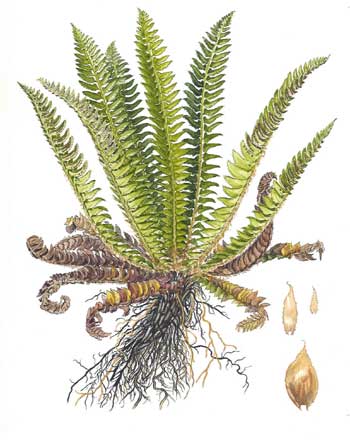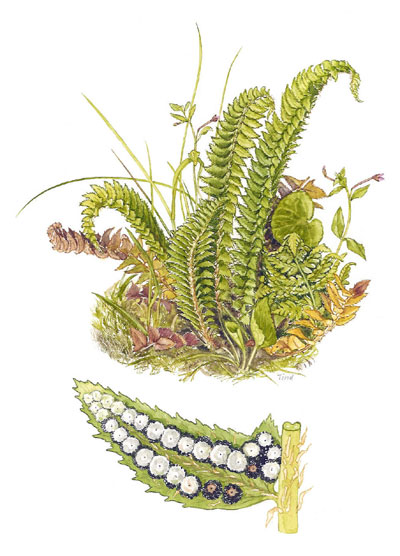| Polystichum lonchitis | ||
Holly fern | ||
|
Etymology
Lonchitis is from the Greek logch meaning spear, hence spear shaped.
Description
Rhizome: erect, scales variable in shape, ovate to lanceolate, gradually narrowing towards apex, pale brown,.
Frond: 40 cm high by 6 cm wide, evergreen, persisting through the following summer, monomorphic, blade/stipe ratio: 8:1. Stipe: grooved, green or straw colored with age, scales light brown, gradually diminishing in size upward, vascular bundles: 5, in an arc. Blade: 1-pinnate, linear, often widest above middle, base narrowed, drooping at the tip, glossy, microscales dense below, glabrous above. Pinnae: 25 to 35 pair, oblong to lanceolate, bending towards the apex, proximal pinnae � deltate, rarely overlapping, in 1 plane, 0.5--3 cm, base truncate to oblique, upper ear well developed; margins serrulate-spiny with teeth spreading; veins free, forked. Sori: round, between costae and margins, only on the upper half of the blade, indusium: peltate, distinct, grayish white, thin, central, sporangia: dark brown or black, maturity: mid to late summer. Culture
Habitat: rock crevices or at base of boulders, mostly in boreal and subalpine coniferous forests or alpine regions.
Distribution: Europe, Siberia, Himalaya, Japan and N. America, Greenland.
Hardy to -35�C, USDA Zone 3.
Synonyms
Polypodium lonchitis Linnaeus Aetopteron lonchitis House Aspidium lonchitis (L.) Swartz Dryopteris lonchitis (L.) O. Kuntze Hypopeltis lonchitis Tod. Polystichum asperum Bubani |
|
|

Polystichum lonchitis. Five vascular bundles in the stipe. �Drawing from Ferns of Northeastern United States, Farida A. Wiley, 1936. |

Polystichum lonchitis. a) fertile frond, b) pinna with mature sori, c) sorus, d) lower surface of sterile pinna. �Illustration by V. Fulford from Ferns and Fern Allies of Canada, William J. Cody and Donald M. Britton, 1989, � Agriculture Canada, used with permission. |

Polystichum lonchitis. Habit and stipe scales. Note last year's fronds in evidence. �Illustration from Scandinavian Ferns by Benjamin �llgaard and Kirsten Tind, Rhodos, 1993. |
